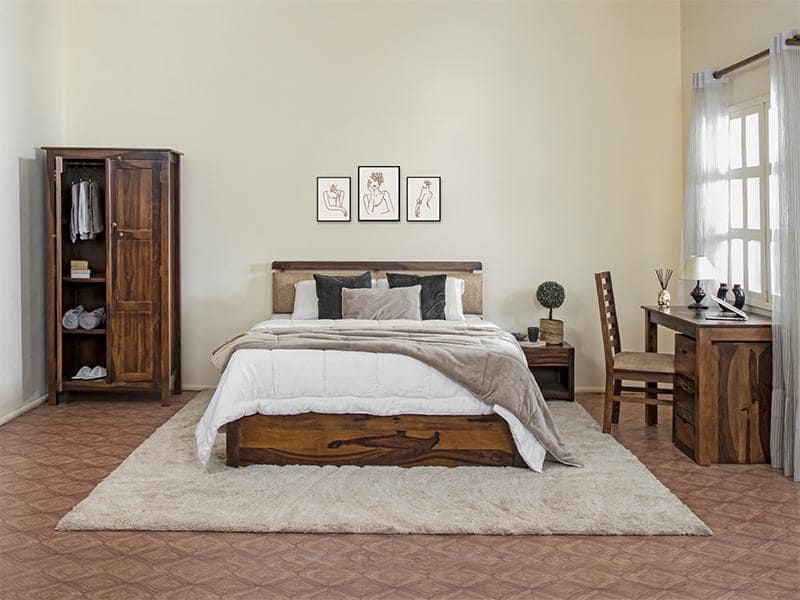
Have you noticed your wood furniture looking a little dull lately? Don’t worry, it happens to the best of us. Wood furniture requires regular cleaning and maintenance to keep it looking its best. The good news is, with a few simple tricks using ingredients you already have at home, you can have your wood furniture looking brand new again in no time. In this article, we’ll walk you through how to clean and care for your wood furniture using natural products like vinegar, olive oil, and lemon juice. These methods are non-toxic, inexpensive, and gentle enough for most wood types. Your furniture will be sparkling clean and moisturized when you’re done. So roll up your sleeves, grab your supplies, and let’s get cleaning! Your wood furniture will thank you.
1- Gather Your Supplies: Vinegar, Olive Oil and Soft Cloths
To get your wood furniture sparkling clean again, you’ll want to gather a few simple supplies: white vinegar, olive oil, and soft cloths.
Vinegar is a natural disinfectant and degreaser that cuts through built-up grime and leaves wood looking fresh. Olive oil nourishes the wood and brings back its natural luster. As for the cloths, microfiber ones are ideal since they won’t scratch the surface.
- Make a vinegar cleaning solution of equal parts white vinegar and warm water. Dip your cloth in the solution and wring out any excess liquid so it’s not sopping wet.
- Wipe down the entire surface of the furniture using the vinegar solution, scrubbing away any stuck-on debris. Pay extra attention to carved details and grooves where dust collects.
- Let the vinegar solution sit for 5-10 minutes, then buff with a dry cloth to remove any remaining moisture.
- Apply a small amount of olive oil to a cloth and rub it onto the wood using small circular motions. Wipe away any excess with a clean cloth.
- For an extra shine, buff the wood with a soft cloth to bring out its natural glow.
With some simple natural products and a little elbow grease, you’ll have your wood furniture looking brand new again. The best part is you don’t need harsh chemicals – just items you already have in your pantry. Your furniture and the environment will thank you!
2- Dust and Wipe Down the Wood Furniture
To get your wood furniture sparkling clean, start with a simple dusting and wipe down.
- Use a microfiber duster, cloth, or dusting wand to remove surface dust and debris. Get into all the nooks and crannies, like drawer pulls, legs, and trim. For larger flat surfaces, you can also use a vacuum with proper attachments and low suction.
- Next, dampen a clean microfiber cloth with water or a wood furniture cleaner and gently wipe the entire surface of the piece. Make sure the cloth is wrung out well so it’s not sopping wet. Too much moisture can damage the wood finish.
- For stuck-on messes or spots, use a bit of vinegar, olive oil, or a commercial wood polish on the cloth to help lift the dirt without damaging the finish. Mineral or jojoba oil also work great for polishing and protecting wood. Apply in the direction of the grain using small circular motions.
- For white wood pieces in particular, a paste of baking soda and water or hydrogen peroxide can help brighten and whiten the wood without bleaching it. Be very gentle while scrubbing to avoid damaging the finish.
- Once done wiping and spot-cleaning, buff the entire surface with a dry microfiber cloth to bring back the shine and luster. Your wood furniture will be clean as new and ready to impress! With regular gentle cleaning and polishing, you can keep your wood furniture looking its best for years to come.
3- Make a Vinegar and Olive Oil Solution
For wood furniture, a simple solution of vinegar and olive oil works great for cleaning and polishing. Here’s how to make it:
Mix equal parts white vinegar and olive oil in a spray bottle. The vinegar helps disinfect and cut through grime, while the oil moisturizes the wood and gives it a nice shine. For most wood types, a ratio of 1:1 or 2:1 vinegar to oil works well.
- For lighter woods like pine or maple, use a higher concentration of vinegar, around 2:1.
- For darker woods like mahogany or walnut, use a lower concentration of 1:1.
Gently shake the solution to combine and you’re ready to clean and condition your wood furniture. Be sure to test in an inconspicuous area first to check for any undesirable effects.
This natural solution is very versatile and can be used to:
- Dust and wipe down wood surfaces. Spray onto a microfiber cloth and wipe clean.
- Polish wood and bring back a shine. Spray directly onto wood and buff with a soft cloth.
- Clean stuck-on messes and stains. Spray onto the area and let sit for several minutes, then wipe clean with a damp cloth.
- Freshen up wood and leave a light, natural oil finish. Wipe on with a cloth and do not buff completely dry.
The vinegar helps sanitize the wood without leaving behind chemical residue. And the olive oil moisturizes the wood and leaves behind a protective, natural coat. For the best results, reapply the solution every few months or when water no longer beads up on the wood. Your wood furniture will stay clean, conditioned and looking its best.
4- Apply the Solution and Wipe Clean
Apply the Cleaning Solution
Now that you’ve assembled your supplies, it’s time to clean your wood furniture. Apply the solution of your choice—either oil and vinegar, lemon juice, or a commercial wood cleaner—with a soft, lint-free cloth. For oil and vinegar, dip the cloth in the solution and wring out any excess. For lemon juice or wood cleaner, spray it directly onto the wood or onto the cloth.
Gently wipe the entire surface of the furniture using small circular motions, paying extra attention to any visibly dirty or stained areas. Don’t scrub too hard, as this can damage the wood finish. For stuck-on messes, let the solution sit for a few minutes before wiping away.
- Be sure to wipe with the grain of the wood. Wiping against the grain can leave tiny scratches in the surface.
- Don’t forget to clean any carved or turned legs, undersides, and backs of the furniture.
- For white wood furniture, you may need to do an initial deep clean to remove built-up grime before maintaining with regular cleaning.
Buff and Protect
Once you’ve wiped the entire surface clean, buff the wood with a soft, dry cloth to bring back the shine and natural luster. This also helps remove any remaining cleaning solution residue.
Apply a wood protectant like furniture wax, oil, or sealant. These protectants moisturize the wood and protect the finish from water damage and stains. Follow the directions on the product to properly apply. Protecting your wood furniture will keep it looking its best for years to come.
With regular light dusting and cleaning, along with occasional re-application of a wood protectant, your wood furniture will stay clean and beautiful. Be sure to wipe up spills and splatters right away to avoid water damage or stains. By properly caring for your wood furniture using these simple tricks, you’ll keep it looking brand new.
5- Protect and Condition the Wood
Once you’ve cleaned your wood furniture, it’s important to protect and condition the wood to keep it looking its best. Wood can dry out and crack over time, so moisturizing it regularly is key.
Use Furniture Oil or Wax
Apply a wood oil, wax, or polish according to the directions on the product. Popular options include:
- Linseed or tung oil: Natural oils that penetrate deep into the wood. Apply with a soft cloth, rubbing with the grain. Let it soak in and buff away excess.
- Beeswax or carnauba wax: Creates a protective coating and subtle sheen. Gently rub on with a cloth, then buff to a shine with a soft brush.
- Furniture polish: Spray-on products containing wax, oil, and solvents to clean, protect and shine wood. Follow directions to apply and buff.
Re-apply the product once a month or so to keep wood nourished. For white wood furniture, choose a product specifically for light-colored woods to avoid darkening the surface.
Use a Damp Cloth for Spot Cleaning
For small spills and spots, wipe the area with a damp cloth to remove dirt and grime. Then reapply your chosen oil, wax or polish to the area to recondition the wood. Be very careful not to soak the wood with too much water, especially for pieces with intricate carvings.
Avoid Harsh Chemicals
Don’t use abrasive cleaners, strong detergents or too much water which can damage the wood finish and dry out or warp the wood. Avoid dousing wood with disinfecting wipes or sprays which often contain bleach and harsh chemicals. For disinfecting wood, opt for a natural oil-based product with essential oils like lemon or lavender oil which have natural antimicrobial properties.
By properly protecting and conditioning your wood furniture, you’ll keep it looking beautiful for years to come. With regular TLC, your wood pieces will become family heirlooms to pass down to future generations.
6- Polish and wax wood furniture
Clean and Condition the Wood
To keep your wood furniture looking its best, regular polishing and waxing is key. About once a month, give your wood pieces a good wipe down to remove built-up grime and prepare the surface.
Mix equal parts white vinegar and olive oil or mineral oil to make an all-natural wood cleaner and conditioner. The vinegar cuts through dirt and residue, while the oil moisturizes the wood and protects the finish. Apply the solution with a soft cloth, rubbing with the grain of the wood. Buff off any excess with a clean, dry cloth.
For stuck-on messes, make a paste from baking soda and water and gently scrub off the stain with an old toothbrush before wiping clean with the vinegar and oil solution.
Apply Furniture Wax or Polish
After cleaning the wood, apply a furniture wax, polish, or oil to protect the surface and enhance the natural beauty of the grain. Paste waxes provide the most durable protection, while polishes and oils need to be reapplied more often.
Wipe the wax or polish onto the wood using a soft cloth, rubbing with the grain. Let it dry as directed, then buff off any excess with a clean cloth to bring out a soft glow. For white wood furniture, choose a wax or polish specifically for light-colored woods to avoid darkening the surface.
With regular polishing and waxing, your wood furniture will stay looking fresh and new for years to come. An occasional deep conditioning with furniture oil or beeswax will moisturize the wood and further protect the finish from water damage or drying out. Keep your wood furniture out of direct sunlight when possible and avoid harsh chemicals that can strip the protective coating.
Parting Words
So there you have it, a few easy tricks to get your wood furniture sparkling clean again. With some vinegar, olive oil, lemon juice and elbow grease, you’ll have your dining table, chairs, cabinets and dressers looking as good as new. No need for harsh chemicals – just simple, natural ingredients you already have in your pantry. Give these methods a try and your home will be smelling fresh and clean in no time. And the best part is you saved money by avoiding expensive wood cleaners and did your part for the environment. Pat yourself on the back for a job well done and enjoy your newly refreshed space! The effort was well worth it.

